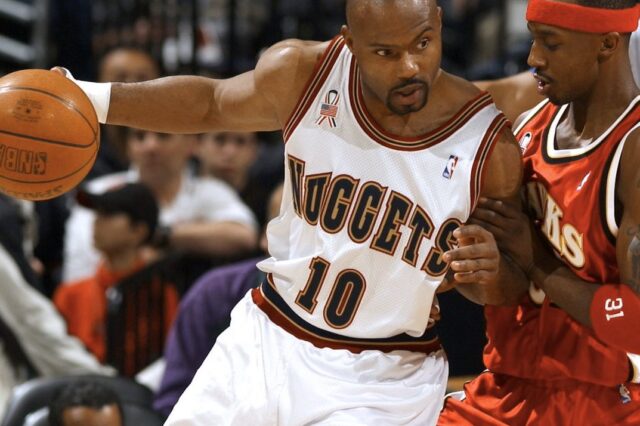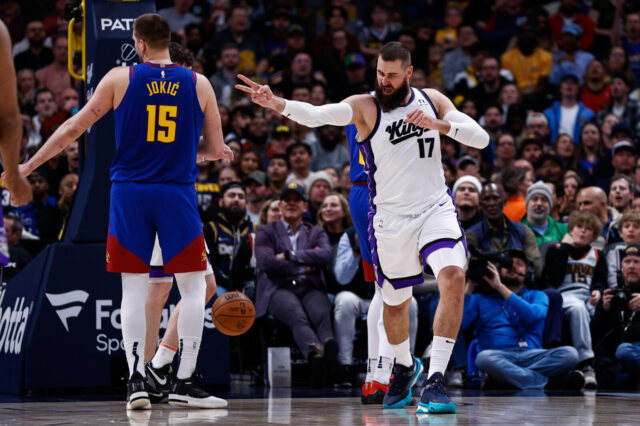I want to preface this article by pointing readers to an article we did last season (The Truth about Andre Miller and the value of lineups) where we pointed out the fairly obvious point that the goal of a basketball game is to score more points than your opponent. We also detailed the various ways a basketball team can be constructed to accomplish this goal. Poor analysts tend focus on offensive statistics when deciding whether a team won or lost a trade. Instead, we'll be viewing this trade from the perspective of net offensive and defensive impact. We'll go on to look at the differences between Iguodala and Afflalo, take a high level look at Iguodala's strengths and weaknesses, and then finally describe what to expect next season.
Defensive Impact
Firstly, Andre Iguodala is an elite, top-3 wing defender in the NBA along with LeBron James and Tony Allen. In each basketball game, a team will generally play an equal number of defensive possessions as offensive possessions. A player who scores 10 points every 100 possessions but gives up 10 points every 100 possessions on defense is a wash – he’s not a positive or negative player. Likewise, you can replace that same player with a guy who scores 5 more points every 100 possessions or limits an opponent to 5 points less every 100 possessions and achieve the same impact – a net positive player. Defense tends to be more valuable than offense as there’s less variance on defense and less variance equates to more wins.
A great example of the importance of variance is the 2010 NFL season where the Packers had a point differential of 148 points, whereas the Steelers had a point differential of 143 points. The Packers finished 10-6 while the Steelers finished 12-6. The Steelers tended to win closer games and play a lower variance style, and as a result, won a couple more close games. By point differential, the Packers were the superior team but won fewer games due to their volatile style where one week they'd win 40-10 and another they'd lose 21-18. The two teams met in a close Super Bowl and the Packers won. Defense also tends to be undervalued in the market, as it's not as glamorous or easy to identify as elite offense. An elite defender who is below average on offense is almost never considered a superstar whereas an elite offensive player who can't play a lick of defense is considered a superstar.
From a team building perspective, we view Iguodala and Carmelo Anthony interchangeably. That is, we don’t consider either player a true superstar but we consider each to be a net positive player. Carmelo is a positive player because he is able to create offense and get a shot off against elite NBA defenses. However, his team defense leaves a lot to be desired. Similarly, Iguodala is as elite of a defender as Carmelo is as an offensive player, however his offense leaves a lot to be desired. Examining both players’ win shares stats, Carmelo at .129 and Andre at .126, further reinforces this opinion. Did we mention that Andre Iguodala makes $5 million less per year than Anthony? Yeah, about defense being undervalued.
In the modern NBA, you must defend both the paint and the perimeter. There are three traits that define an elite NBA defender. The first is hustle or motor, the second is natural ability, which we'll define as length and athleticism, and finally intelligence and understanding of the defensive scheme. We'll do a follow-up piece on this, but for now we'll just state that Iguodala has all three characteristics in spades and we'll show you the evidence on film later.
Andre Iguodala vs Arron Affalo
For this discussion we're going to ignore last year's stats and use career stats, which are less susceptible to randomness and noise from a single season. Even trivial stats such as individual free throw percentage exhibit fairly large season-to-season swings.
Andre Iguodala had a bit of an outlier season last year shooting 39.4% from 3-point land. Rather than say he's a 39.4% shooter; we're instead going to factor that performance into his career averages and use that as a baseline for what to expect going forward. Likewise, his FT% was a career low 61.7% last year and it's more likely that he'll regress to his career average of 73.7% next year.
So how does Iguodala compare to Afflalo? Well, Afflalo is the more efficient offensive player as measured by eFG% and TS% where he shoots 53.8% and 57.8%, respectively, compared to Iguodala's 50% and 53.8%. Additionally, if you factor in career trajectories, Afflalo should now be peaking and has been more efficient in recent years while Iguodala's skills should start to decline. Absolute percentages don't tell the whole story, however. Iguodala had a 19.6% usage rate compared to Afflalo's 16.9% usage rate. As usage increases, efficiency tends to decrease and thus, with similar usage rates, Iguodala's expected contribution and efficiency projects fairly similar to Affalo's. Philadelphia had a putrid offense last year where an inefficient Iguodala was often times their best option whereas Afflalo took most of his shots within the confines of the offense. In fact, the Philadelphia offense looked similar to our half-court offense if you took out transition baskets.
The biggest difference in their games is how they get their shots. Iguodala has the athleticism and length to create his own shot and can get it off whenever he wants while Afflalo relies more on teammates creating opportunities. This is evidenced by the percentage of their shots assisted. Iguodala was assisted on about 50% of his made baskets while Afflalo was assisted on 76% of his made baskets! In other words, with increased open opportunities, decreased usage, and drawing less of the opposing defense’s focus, I’d expect Iguodala’s offensive contribution to look similar to Afflalo’s. Subjectively, what this will look like is frustrating and terrible half-court offense where the Nuggets settle for Iguodala long, contested twos when the shot clock runs down. In transition, Afflalo’s numbers were slightly better at 1.26 points per possession compared to Iguodala’s 1.19. However, Iguodala runs hard in transition and his numbers should get better playing for a team that places a greater emphasis on transition offense.
Iguodala does a better job of creating for teammates with an AST% almost twice that of Afflalo's, is a significantly better rebounder with an OReb% of 3.3% to Afflalo's 1.3% (offensive rebounding rate are a better measure of rebounding skill than defensive rebounding rate). Afflalo turned it over less than league average with a TOV% of 10.1% while Iguodala turned it over at a 14.6% clip, primarily off the dribble.
Next is shot selection. Afflalo tends to balance his spot-up jumpers with dribble drive penetration while Iguodala tends to play more of a perimeter-oriented game, relying on his midrange game. Affalo took about 29% of his shots last year close to the basket, 38% from mid-range, and 32% from three. Iguodala, on the other hand, took 24% of his shots from close to the basket, 45% from mid-range and 30% from three. While Iguodala had an outlier season last year, we'd expect his 3-point percentage to improve with more open opportunities. We'd also prefer if he'd stop taking contested, long 2-pointers and attack the basket or step back and take the three instead.
Finally, defense is where Iguodala really shines over Afflalo. Afflalo had a DRtg of 113 points per 100 possessions while Iguodala had a DRtg of 105 points per 100 possessions. While they both exhibit good hustle and motor as well as recognition and understanding of team defensive concepts, Afflalo just doesn't have the length or athleticism to alter shots the way Iguodala does. There were many times where opponents were able to shoot fairly comfortable over Afflalo, even though he played fairly good defense. Opponents won't be able to do that with Iguodala's length and athleticism. Additionally, Iguodala gets more steals (about 1 more per 36 minutes), defensive rebounds at a higher rate (> 5% higher DReb%), and commits 1 less foul per 36 minutes- all things that correlate with ending positions and good team defense.
The Good, The Bad, and the Ugly
Let's start with the good. Iguodala defends at an elite level. Our perimeter defense was awful last year, particularly from three. With Iguodala, our perimeter defense should be shored up and we have a strong shutdown defender for the Kevn Durants of the world. He fights through screens as well as anyone in the league.
Here's the bad, Andre Igoudala turns the ball over – a lot. As mentioned above, it's almost entirely because he's not a very good dribbler and loses the ball when making moves to the basket.
The Ugly – watching Iguodala in the half-court is one of the most frustrating things in basketball. In some ways, Iguodala's game resembles a poor mans LeBron James in that he defends at an elite level but struggles in the half-court. Remember the LeBron before this year's playoffs that would become passive in half court sets and settle for jumpers? That's Iguodala's offensive game without the ability to get to the hole at will and without any semblance of a post up game. It's almost entirely contested, spinning, or fading jumpers.
Wrapping It All Up
There are times, from a team synergy perspective, where a player happens to fit in perfectly and shore up a team's weaknesses. This trade is one of those situations and we expect this trade to pay dividends for the Nuggets next year. We're effectively shoring up two weaknesses with one trade. The first is our performance in high leverage situations where we need to get a shot off while managing the clock. While Iguodala's not the most efficient isolation player in the world, getting the shot off, with some chance of going in plus giving your team a chance at the offensive rebound is significantly better than the turnover alternative. We're also replacing a solid defender with an elite defender when our team defense, particularly our perimeter defense was one of our greatest weaknesses.
Net-net, we expect the Nuggets’ offense to remain similar in terms of efficiency while being slightly more frustrating to watch (think of the difference between watching Wilson Chandler and AAA). Iguodala will directly benefit from Denver’s ability to create open threes. Additionally, Iguodala thrives in transition and his athleticism and motor really shine when he’s out running.
A mere three points per 100 defensive possession improvement, assuming similar offense efficiency, would put the Nuggets just outside the NBA's elite of the San Antonio Spurs, Miami Heat, Oklahoma City Thunder, Los Angeles Lakers, and Chicago Bulls with a core of players that's likely to continue improving while having the athleticism and length to compete with anyone in the league.


